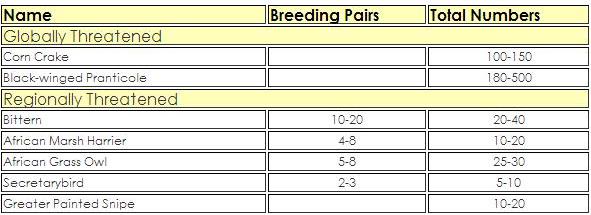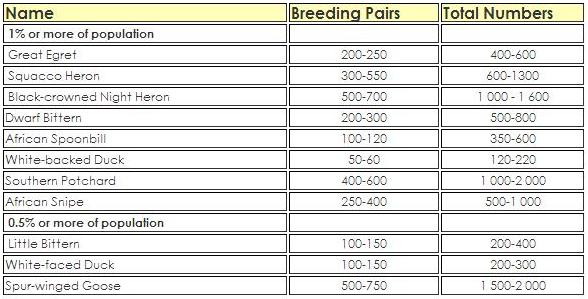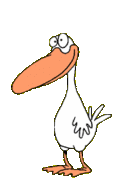IBA Nyl River Floodplain
SA Number: SA101
Status: Global IBA -A4i, iii
Site Description
The Nyl River forms a 70 km long, 16 000 ha grass floodplain, one of the largest in South Africa. It runs from 10 km south of Naboomspruit north to Potgietersrus. The area, known as Nylsvley, is located in extensive undulating to flat terrain between 1 050 and 1 080 m a.s.l. The floodplain starts to widen at the western edge of Nylsvley Nature Reserve and it attains its greatest width, of five to six kilometres, on the farms downstream from there; Vogelfontein, Weltevreden, Zyferkraal, Du Toits Kraal (the last three embraced by the Mosdene Private Nature Reserve), Groenvaley and Zandpan. At its northern end, on the farm Vaalkop, it narrows and assumes the character of a normal river. The only prominent hills occur at Maroelakop (1 140 m a.s.l.) and Stemmerskop (1 090 m a.s.l.), both are on Nylsvley Nature Reserve and are in close proximity to each other. The system derives its floodwaters from rain that falls in the nearby foothills of the Waterberg range (IBA SA007). About 12 tributaries drain this area and dis- charge their water onto the floodplain at various points along its course. In general, the climate is semi-arid, with three rather distinct seasons; a hot wet season from November to April during which the Nyl River occasionally floods, a cool dry season from April to August, and a hot, dry season from August to October. The annual average minimum and maximum temperatures are 12°C and 26.4°C respectively and the mean rainfall is c. 600 mm p.a.
This is the largest wetland of its kind in South Africa and it is basically a grass-dominated, seasonally inundated flood- plain, which in years of poor rainfall may not be flooded at all. It requires rainfall of at least 10% above the annual mean to produce significant inundation. The ephemeral nature of the wetland, and the kind of vegetation and microhabitats it provides, accounts for the floodplain's attractiveness to a wide variety of wetland bird species, many of which breed in large numbers in years of suitable rainfall. The dominant grass in flooded areas is
Oryza longistaminata, which may grow up to 2 m tall and provides cover, food and nesting material for many wetland birds.
Bushes and trees, isolated and in clumps, including many
Acacia spp., are scattered throughout the floodplain and provide nesting sites for herons, bitterns and egrets. The floodplain has very little permanent reedbed vegetation. A particularly interesting aspect of the vegetation is the occurrence of a tropical grass,
Paspalidium germinatum, which is recorded from nowhere else in South Africa. On some of the high-lying areas the vegetation comprises broadleaved savannas and grassland; dominants include
Eragrostis pallens and
Digitaria eriantha.
Birds
The area has a list of 426 bird species, about 46% of the species found in southern Africa. The floodplain occasionally erupts with activity, holding up to 80 000 birds during high rainfall years. Nylsvley is particularly important as it attracts large numbers of locally threatened and rare waterbirds. In high-rainfall years, Dwarf Bittern Ixobrychus sturmii, Little Bittern Ixobrychus minutus, Allen's Gallinule and Lesser Moorhen are common. Other rare species, such as the Slaty Egret, Rufous-bellied Heron, Streaky-breasted Flufftail and Baillon's Crake, breed erratically, whenever conditions are suitable. A relatively large Corn crake population occurs here in the austral summer. Striped Crake and Spotted Crake are occasional summer visitors. The wetland also occasionally supports extremely large numbers of Great Egret, Little Egret, Yellow-billed Egret, Squacco Heron, Black-crowned Night Heron, African Spoonbill and Southern Pochard. Marabou Stork and Black Stork occur rarely at Nylsvley. Yellow-billed Stork and African Grass Owl are fairly common in the flooded grasslands and Black-winged Pratincole occasionally occur in large numbers in the drier grassland surrounding the floodplain. Almost every species of South African duck is found here from time to time, some in very large numbers.
The surrounding woodland holds Secretarybird, White- backed Vulture in small numbers. Cape Vulture is a scarce visitor. Other woodland specials include Red-crested Korhaan, Southern Pied Babbler, White-throated Robin-Chat, Kalahari Scrub Robin, Burnt-necked Eremomela, Barred Wren Warbler, Marico Flycatcher, Crimson-breasted Shrike, Southern White-crowned Shrike, Burchell's Starling, Scaly-feathered Finch, Violet-eared Waxbill Uraeginthus granatinus, Black-faced Waxbill and Shaft-tailed Whydah.
Key Species
Threatened Species
 Range and Biome Restricted Species
Range and Biome Restricted Species
 Congregatory Species
Congregatory Species
 Other threatened/endemic wildlife
Other threatened/endemic wildlife
Large mammals are well represented in Ndumo, including endangered species such as the White Rhinoceros Ceratotherium simum, Black Rhinoceros, Red Duiker, Aardwolf, Suni, Leopard, Serval and Crocodile. Many distinctive and interesting trees are at their southernmost limit here. Examples are
Combretum imberbe,
Sterculia rogersii,
Pterocarpus rotundifolius,
Lonchocarpus capassa,
Acacia albida and
Entandrophragma caudatum. The latter is a single, large, old specimen far removed from its nearest kin.
Downlaod PDF Site Description






